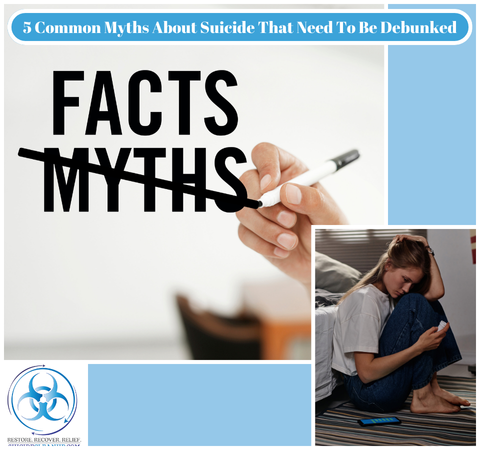How To Clean Up After A Suicide
October 2, 2024Understanding the myths surrounding suicide is a vital component of suicide awareness and mental health education. These misconceptions can perpetuate stigma, hinder open discussions, and ultimately impede effective prevention efforts. By addressing these myths head-on, we foster an environment where individuals feel safe to share their struggles and seek help without fear of judgment.
The importance of mental health discussions cannot be overstated; they play a vital role in suicide prevention. When we engage in conversations about mental health openly, we dismantle the fears that often accompany such topics. This openness not only empowers those struggling with their mental well-being but also equips their loved ones with the knowledge needed to provide support.
5 Common Myths About Suicide
By debunking harmful myths about suicide, we contribute to a culture of understanding and compassion—one that lays the groundwork for effective suicide prevention efforts.
Myth 1: Talking About Suicide Can Encourage It
One of the most pervasive myths surrounding mental health is the belief that discussing suicide can somehow encourage individuals to take their own lives. This notion stems from a well-intentioned desire to protect those who may be struggling; however, it ultimately perpetuates a harmful cycle of silence and stigma. In reality, open conversations about suicide are crucial for prevention.
By breaking down the barriers of silence, we create a safe space for individuals to express their feelings and struggles. Talking about suicide does not romanticize or glorify it; instead, it allows people to share their pain and seek help without fear of judgment. This dialogue can foster understanding, compassion, and support among friends, family members, and communities.
Encouraging open discussions about suicide not only helps reduce stigma but also empowers individuals to reach out for support when they need it most. By addressing this myth head-on, we take a significant step towards creating a society where mental health is prioritized, and everyone feels heard and understood.
Myth 2: Only People with Mental Illnesses Consider Suicide
Another myth about suicide is the belief that only individuals diagnosed with mental health disorders are at risk. This misconception can lead to a dangerous oversight, as it fails to recognize the complex interplay of factors that contribute to suicidal thoughts and behaviors. While mental health disorders do indeed heighten suicide risk, they are not the sole contributors. Many individuals experience significant emotional distress without a formal diagnosis, which can equally lead them to contemplate suicide.
Situational issues, such as loss of a loved one, financial hardship, or significant life changes, can lead to intense emotional pain that may drive someone to consider suicide. It’s crucial to recognize that chronic mental health issues are not the only contributors; situational crises can trigger profound feelings of despair in otherwise healthy individuals.
Understanding that suicide risk is not confined to those with diagnosed mental illnesses allows for a more compassionate view of this critical issue. It encourages open conversations about emotional well-being and emphasizes the importance of providing support to anyone experiencing significant distress—diagnosed or not.
Myth 3: People Who Talk About Suicide Don’t Mean It
One of the most dangerous misconceptions surrounding suicide is the belief that individuals who talk about it are merely seeking attention or do not genuinely intend to take their own lives. This myth can lead to a lack of urgency in addressing warning signs of suicide, which can have tragic consequences. In reality, discussing suicidal thoughts is often a significant indicator of distress and should be taken seriously.
Many people who contemplate suicide feel isolated and overwhelmed by their circumstances, and they may express their feelings verbally or through writing. Recognizing these conversations as serious warning signs of suicide is crucial in identifying individuals at risk. Risk factors such as mental health disorders, substance abuse, a history of trauma, and significant life changes can contribute to suicidal ideation. Understanding these factors allows friends, family members, and professionals to implement effective prevention strategies. Engaging in open dialogues about mental health, providing emotional support, and encouraging professional help can create a safety net for those in need.
It’s crucial not to underestimate the seriousness of anyone talking about suicide. By acknowledging this reality and taking proactive steps toward prevention, we can foster a culture of understanding and support that helps save lives.
Myth 4: Once Someone is Suicidal, They Will Always Be Suicidal
The 4th myth we are going to cover is the belief that once someone experiences these feelings, they are destined to struggle with them indefinitely. This notion can be deeply damaging, as it overlooks the changing nature of suicidal thoughts and the potential for recovery. In reality, many individuals face temporary crises that can lead to suicidal ideation but do not signify a permanent state of being.
Suicidal ideation often arises during periods of intense emotional distress, such as overwhelming grief, depression, or anxiety. However, these feelings are typically not permanent; with appropriate support and intervention, individuals can find pathways to healing and regain hope. Mental health professionals emphasize that recovery is possible and that many people who have contemplated suicide go on to lead fulfilling lives.
It is essential to recognize that recovery is possible. With the right support and resources in place, many people move beyond their darkest moments to lead fulfilling lives. Understanding this allows us to foster a more compassionate perspective towards those in crisis—highlighting the importance of timely intervention and ongoing support in mental health care.
Myth 5: There’s Nothing You Can Do to Help Someone Who is Suicidal
Contrary to this myth, there are numerous ways you can effectively support someone who is experiencing suicidal thoughts or behaviors. One of the most crucial steps in providing help is developing a safety plan for at-risk individuals. This plan outlines specific actions that the person can take when they feel overwhelmed, including identifying warning signs, coping strategies, and emergency contacts.
Supportive communication techniques also play a vital role in helping someone who is suicidal. Listening without judgment, validating their feelings, and encouraging open dialogue can foster trust and make it easier for them to express their emotions. It’s important to approach these conversations with empathy and patience.
Additionally, educating yourself about available resources for help—such as crisis hotlines or mental health services—can empower you to guide someone toward professional assistance when needed. By taking these proactive steps, you can play a vital role in supporting someone who may be struggling with suicidal thoughts and potentially save a life.
Combating Myths About Suicide and Supporting Those in Need
In order to combat these myths you can use two avenues; get involved in community efforts and utilize social media.
Community Efforts
There are various ways communities can play a role in supporting those in need. One way is through community awareness programs that educate the public on the realities of mental health issues and dispel harmful misconceptions surrounding suicide. These programs often involve workshops, seminars, and outreach initiatives that aim to inform individuals about the signs of mental distress and available resources.
Local resources for mental health support are another component of these initiatives. By promoting access to counseling services, hotlines, and peer support groups, communities can ensure that individuals struggling with suicidal thoughts feel less isolated. It is vital to build a supportive environment where people feel safe to share their experiences without fear of judgment.
Social Media
The role of social media in shaping public perceptions of sensitive topics, such as suicide, cannot be overstated. With its vast reach and instantaneous nature, social media platforms have become arenas for discussions about mental health and suicide. However, this influence comes with both positive and negative implications.
Social media influence on mental health discussions can lead to both positive and negative outcomes. On one hand, platforms can provide vital support networks for individuals struggling with suicidal thoughts or behaviors. These communities often foster open dialogue and share resources that may help those in need. Conversely, the same platforms can perpetuate harmful stereotypes and inaccurate information about suicide rates online.
Misinformation about suicide rates online can perpetuate harmful stereotypes and stigmas surrounding mental health. For instance, sensationalized posts may exaggerate the prevalence or causes of suicide, leading to public misunderstanding and fear. This underscores the necessity for responsible sharing practices among users and the importance of verified sources when discussing such sensitive topics.
Breaking Down Barriers—Better Understanding and Prevention of Suicide
In conclusion, debunking the myths surrounding suicide is essential for creating a compassionate and informed society. Misconceptions about suicide not only reinforce stigma but also prevent people from seeking the help they need. By fostering open discussions, promoting mental health education, and offering supportive resources, we can empower individuals and communities to approach this sensitive topic with empathy and understanding. Through these efforts, we contribute to a culture that prioritizes mental well-being, breaks down barriers to care, and ultimately saves lives. Remember, each of us has a role to play in supporting those who may be struggling—by reaching out, listening, and advocating for a world that values and supports mental health.
If you or a loved one are in need of urgent help visit our resources page to find a Mental Health Therapist near you.


